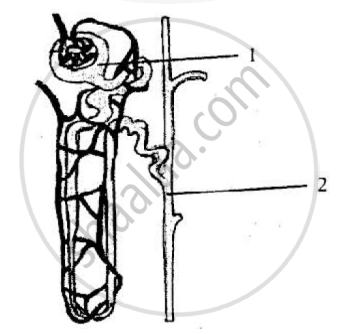Advertisements
Advertisements
प्रश्न
The diagram given below is that of a structure present in a human kidney.
Study the same and answer the questions that follow:

1) Name the structure represented in the diagram
2) What is the liquid entering part ‘1’ called?
Name two substances present in this liquid that are reabsorbed in the tubule.
3) What is the fluid that comes to part ‘2’ called?
Name the main nitrogenous waste in it.
4) Mention the three main steps involved in the formation of the fluid mentioned in (iii) above
5) Name the substance which may be present in the fluid in part ‘2’ if a person suffers from Diabetes mellitus.
उत्तर
1) Nephron
2)
- Glomerular filterate
- Glucose and Amino acids
3)
- Urine
- Urea
4) The 3 steps are
- Ultrafiltration
- Selective Reabsorption
- Tubular secretion
5) Glucose
APPEARS IN
संबंधित प्रश्न
Name a waste gas released by the plants only during the daytime.
Describe the mechanism of urine formation in human excretory system. Draw a labelled diagram to illustrate your answer.
The procedure of cleaning the blood of a person by using a kidney machine is known as:
(a) ketolysis
(b) hydrolysis
(c) dialysis
(d) photolysis
Name the following:
The vein in which urea concentration is maximum
Given below is a set of five terms. Rewrite the terms in their correct order so as to be in logical sequence.
Renal artery, urethra, ureter, kidney, urinary bladder.
Name the Following
The blood vessels which brings pure blood to the kidneys:
Write the functional activity of the following structure: Nephron
Choose the correct option.
Which one of the following organisms would spend maximum energy in the production of nitrogenous waste?
Why is the rate of breathing in aquatic organisms much faster than in terrestrial organisms?
What is the purpose of making urine in the human body?
